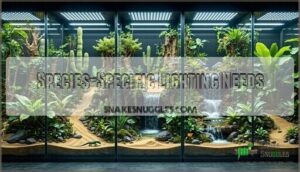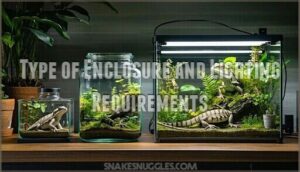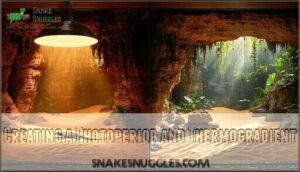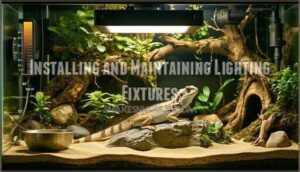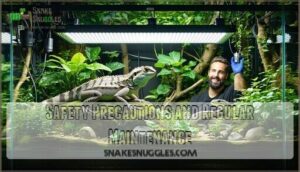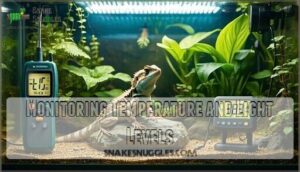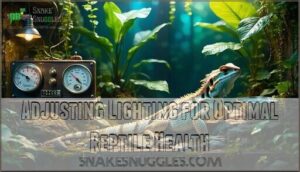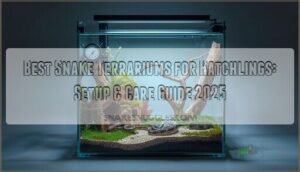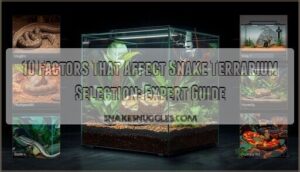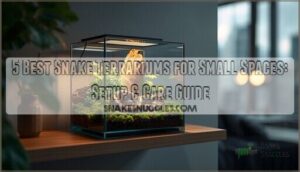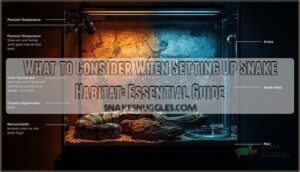This site is supported by our readers. We may earn a commission, at no cost to you, if you purchase through links.
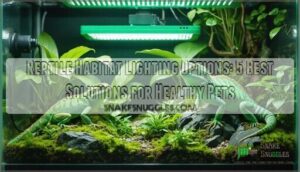
UVB fluorescent bulbs are your best bet—they’re like sunshine in a tube, helping reptiles synthesize vitamin D3 for strong bones.
Don’t fall for heat-only incandescent bulbs; they’re basically expensive space heaters without the UV benefits.
LED lights save energy but often skimp on UVB output.
Create temperature gradients with basking spots, and remember that different species have unique lighting needs—what works for your bearded dragon won’t suit your gecko.
The secret lies in understanding how lighting affects behavior, metabolism, and overall well-being, and finding the right balance is crucial for the well-being of your reptiles.
Table Of Contents
- Key Takeaways
- Reptile Lighting Basics
- Top 5 Reptile Lighting Options
- Choosing Reptile Lighting
- Setting Up Reptile Lighting
- Frequently Asked Questions (FAQs)
- What kind of lighting do reptiles need?
- What’s the difference between a basking light and a heat light?
- Are LED lights ok for reptiles?
- What light is best for a terrarium?
- What UVB strength do different reptile species need?
- How often should UVB bulbs be replaced?
- Can glass or plastic block UV radiation?
- Whats the ideal distance for UVB placement?
- Do nocturnal reptiles need UVB lighting too?
- Conclusion
Key Takeaways
- You’ll need UVB fluorescent bulbs for vitamin D3 synthesis – they’re essential for your reptile’s bone health and calcium absorption, unlike heat-only bulbs that won’t provide UV benefits.
- Create proper temperature gradients with basking spots – position heat sources at one end of the enclosure so your reptile can self-regulate between warm and cool zones for optimal thermoregulation.
- Match lighting to your species’ specific needs – desert reptiles require intense UVB (10-12%), while tropical species need moderate levels (5-7%), and nocturnal reptiles need minimal UV exposure.
- Replace UVB bulbs every 6-12 months – even when they’re still glowing, their UV output degrades over time, potentially causing metabolic bone disease in your reptile.
Reptile Lighting Basics
Your reptile’s health depends on proper lighting that mimics natural sunlight conditions.
Understanding UVB for vitamin D3 synthesis, UVA for natural behaviors, and heat sources for thermoregulation will help you create an ideal habitat environment.
Importance of UVB for Vitamin D3 Synthesis
Without proper UVB lighting, your reptile can’t manufacture the vitamin D3 it desperately needs for survival.
UVB lighting isn’t optional—it’s your reptile’s lifeline for essential vitamin D3 production.
This invisible process happens in your pet’s skin when UVB rays hit specific cells, triggering a chemical reaction that’s absolutely essential for calcium absorption and metabolic health.
Here’s why UVB benefits are non-negotiable for reptile nutrition:
- Vitamin D3 synthesis occurs only through direct UVB exposure between 290-315 nm wavelengths
- Calcium absorption depends entirely on adequate vitamin D3 levels in your reptile’s system
- Metabolic bone disease prevention requires consistent UVB output from quality reptile habitat lighting
- Self-regulating process means UVB-induced vitamin D3 won’t cause overdose like supplements can
Proper reptile care involves understanding the role of UVB light sources in promoting healthy growth and development.
Role of UVA in Promoting Natural Behaviors
Understanding UVA’s behavioral impact helps you create a more enriching reptile habitat.
UVA radiation stimulates appetite, reproductive behaviors, and activity patterns while supporting healthy circadian rhythms.
This invisible wavelength acts like nature’s behavioral trigger, encouraging your reptile to display instinctual behaviors.
Creating a naturalistic environment with proper reptile habitat design is essential for the well-being of your pet.
| UVA Effects | Behavioral Stimulation |
|---|---|
| Appetite Enhancement | Triggers feeding responses and foraging behaviors |
| Reproductive Activity | Stimulates mating displays and breeding cycles |
| Activity Patterns | Promotes natural daily movement and exploration |
| Stress Reduction | Supports psychological well-being through natural lighting |
Natural lighting with proper UVA emission transforms your reptile habitat lighting from basic illumination into thorough animal enrichment that mirrors their wild environment.
Heat Sources for Thermoregulation
Heat sources create the thermal foundation your reptile needs for proper digestion and immune function.
Your reptile’s survival depends on the right heat sources for proper digestion and immune function.
These systems work together to establish essential temperature zones:
- Heat lamps provide focused basking spots with visible light and infrared heat
- Ceramic heat emitters deliver consistent infrared heat without light disruption
- Basking lamps combine warmth with behavioral stimulation for active species
- Thermal gradients allow your pet to self-regulate between warm and cool zones
Top 5 Reptile Lighting Options
Selecting the right lighting setup doesn’t have to be overwhelming when you focus on your reptile’s specific needs.
These five proven lighting solutions cover everything from basic heat sources to extensive UVB systems that’ll keep your scaly friend healthy and active.
1. Reptile basking spotlight light bulbs
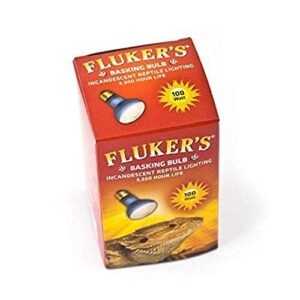
For reptile owners seeking reliable heat sources, basking spotlight bulbs deliver concentrated warmth exactly where it’s needed.
These 75-watt incandescent bulbs focus 35% more heat into a tight beam compared to regular bulbs, creating defined thermal gradients essential for thermoregulation.
They emit vital infrared light that stimulates natural behaviors like appetite and digestion.
While they provide beneficial UVA radiation, you’ll need a separate UVB source for complete lighting, and proper placement prevents burns while maintaining ideal basking temperatures, requiring ceramic sockets due to high heat output.
Best For: Reptile owners needing focused, reliable basking heat for lizards, snakes, or other ectotherms.
- Provides concentrated heat and essential infrared light for reptile health
- Easy to install and fits standard fixtures; heats up quickly for effective basking
- Cost-effective compared to many specialty reptile bulbs
- Shorter bulb lifespan reported by some users
- Does not supply UVB; requires a separate bulb for complete lighting
- Bulbs can shatter during shipping or if not handled carefully
2. Reptile tank clamp lamp fixture
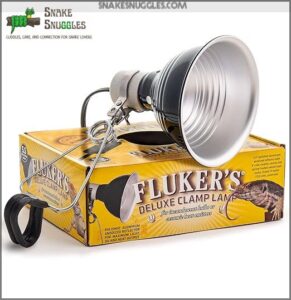
Clamp lamp fixtures offer unmatched versatility for reptile keepers who need flexible lighting solutions.
These 5.5-inch diameter aluminum domes accommodate various bulb types—from ceramic heat emitters to UVB compact fluorescents—making them perfect for creating custom lighting setups.
The heavy-duty ceramic socket handles up to 75 watts safely, while the adjustable clamp attaches securely to terrarium rims or stands.
You’ll appreciate the convenient on/off switch and space-saving design that works brilliantly in smaller enclosures where every inch counts.
Proper custom reptile tank setups require careful consideration of lighting, heating, and ventilation to guarantee the health and well-being of the reptiles.
Best For: Reptile owners who need an affordable and versatile lighting or heating solution for small to medium terrariums.
- Not suitable for bulbs above 75 watts or larger/deeper fixtures
- Clamp attachment can be tricky for first-time users
- May require additional instruction or modification for specialty bulbs
- Compatible with a wide range of bulb types, including heat emitters and UVB bulbs
- Adjustable clamp and compact size allow easy placement in various enclosures
- Durable ceramic socket and metal construction enhance safety and lifespan
3. Reptile Dome UVB Light Fixture
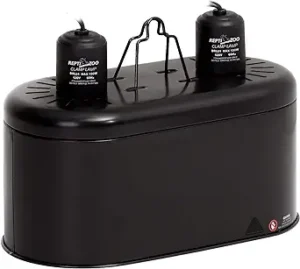
Dome fixture design maximizes UVB output through polished aluminum reflectors that direct essential radiation downward into your reptile’s habitat.
These versatile fixtures accommodate bulbs up to 150W and work with various lamp types including mercury vapor, compact fluorescent, and ceramic heat emitters.
The reflective dome shape increases light efficiency by 40-60% compared to standard fixtures.
Heat-resistant ceramic sockets guarantee safe operation with high-wattage bulbs, while ventilation holes prevent overheating and extend bulb lifespan for consistent UVB delivery.
Best For: Reptile owners seeking reliable, high-efficiency lighting and heating in a variety of terrarium setups.
- Some users report large ventilation holes limit heat retention.
- Occasional durability issues with switches and bulb removal.
- Effectiveness depends heavily on proper bulb selection for reptile needs.
- Increases UVB, UVA, and heat output for optimal reptile health.
- Durable ceramic sockets support up to 150W with safe, long-lasting performance.
- Independent switches and easy installation for convenient, flexible use.
4. Reptile Terrarium Lighting Combo Kit
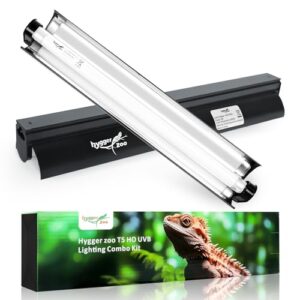
Looking for the ultimate all-in-one solution?
Combo kits deliver everything you need in one convenient package.
These thorough systems include both UVB and heat bulbs, offering full-spectrum coverage that supports vitamin D3 synthesis and thermoregulation.
T5 HO UVB bulbs provide high-intensity output, while polished curved reflectors boost efficiency by 30%.
You’ll get ceramic sockets supporting up to 200W, built-in timers, and mounting accessories for various enclosure types, making it a complete solution.
Best For: Reptile owners who want a reliable, complete lighting and heating setup that ensures the health and well-being of their pets.
- Combines UVB and heat bulbs for full-spectrum coverage, promoting vitamin D3 synthesis and natural behaviors.
- Includes high-efficiency polished reflectors and ceramic sockets that support up to 200W bulbs.
- Comes with convenient features like built-in timers, removable cords, and versatile mounting accessories.
- Some kits may have bulb durability issues, with reports of premature burnout.
- Higher quality kits can be more expensive compared to buying components separately.
- Not all kits fit every enclosure size, requiring careful measurement before purchase.
5. ReptiSun compact fluorescent lamp
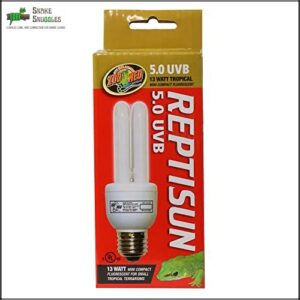
For moderate UVB requirements, this compact fluorescent option delivers 10% UVB and 30% UVA output in a convenient 13-watt design.
You’ll appreciate its cool-burning technology that won’t overheat smaller enclosures while providing essential calcium metabolism support.
The special UVB-transmitting quartz glass maximizes penetration, and it fits standard threaded sockets without requiring a separate ballast.
Replace every 6-8 months to maintain ideal UVB levels for your reptile’s health.
Best For: Tropical reptiles and amphibians in small to medium enclosures that need moderate UVB exposure without added heat.
- Delivers effective 10% UVB and 30% UVA for healthy bone development and natural behaviors.
- Cool-burning design prevents overheating and fits standard sockets without extra equipment.
- Reliable performance with a track record of positive user experiences and support.
- Needs regular replacement every 6-8 months to maintain optimal UVB output.
- Not a heat source; supplemental basking lamps are required for temperature control.
- UVB coverage area is focused—less suitable for large or multi-level enclosures.
Choosing Reptile Lighting
Selecting the right lighting for your reptile requires careful consideration of your animal’s natural habitat and specific physiological needs.
You’ll need to match UVB output, heat requirements, and photoperiod cycles to your species’ evolutionary adaptations for ideal health outcomes.
Species-Specific Lighting Needs
Understanding species-specific lighting needs is vital for your reptile’s health.
Different species have evolved under varying light conditions, requiring customized UVB requirements and lighting cycles.
Proper species research guarantees ideal habitat lighting for your pet’s wellbeing.
Researching the best reptile lighting options is essential for creating a healthy environment.
- Desert dwellers need intense UVB (10-12% output)
- Tropical species thrive with moderate UV levels (5-7%)
- Nocturnal reptiles require minimal UVB exposure
- Basking species demand high-intensity reptile spectrums
- Forest inhabitants prefer filtered, dappled lighting
Age and Health of Your Reptile
Your reptile’s age and health substantially impact lighting requirements.
Younger reptiles need stronger UVB lighting for proper bone development, while senior reptiles may require adjusted photoperiods to support changing metabolic needs.
| Life Stage | UVB Requirements | Health Considerations |
|---|---|---|
| Juvenile | High-output UVB (10-12%) | Rapid growth demands maximum vitamin D3 synthesis |
| Adult | Moderate UVB (5-10%) | Stable metabolism with consistent thermoregulation needs |
| Senior | Adjusted UVB intensity | Reduced activity may require modified photoperiods |
Reptiles with metabolic bone disease need immediate UVB intervention to restore calcium absorption and prevent further skeletal deterioration, which is crucial for their overall health and proper bone development.
Type of Enclosure and Lighting Requirements
Your enclosure’s design dramatically affects habitat lighting performance.
Glass terrariums lose heat quickly, requiring efficient UVB lighting and higher-wattage bulbs.
Mesh-top enclosures can block fifty percent of UVB rays, demanding stronger fixtures or under-mesh installation.
PVC enclosures retain heat effectively, needing lower wattage bulbs with internal terrarium lights for ideal aquarium illumination and reptile lighting requirements.
Understanding proper UVB lighting needs is essential for maintaining a healthy environment.
Setting Up Reptile Lighting
Once you’ve selected the right lighting equipment for your reptile’s species, proper setup becomes vital for creating the thermal and light gradients your pet needs to thrive.
The installation process involves strategic placement of fixtures, careful attention to safety protocols, and ongoing monitoring to guarantee ideal conditions for your reptile’s health.
Creating a Photoperiod and Thermogradient
Every reptile needs proper Light Cycles and Temperature Control to thrive.
Start with a 12-hour Day Night photoperiod using digital timers for consistency. Create your thermogradient by positioning basking lamps at one end, establishing hot zones of 40-42°C for desert species or 28°C for rainforest dwellers.
UVB lighting should overlap your basking area. This Gradient Creation lets your pet self-regulate perfectly.
Maintaining proper temperature gradients is essential for the health and well-being of reptiles.
Installing and Maintaining Lighting Fixtures
Once you’ve established proper lighting cycles and temperature gradients, fixture placement becomes your next priority.
Position UVB lighting fixtures 6-12 inches above basking spots, guaranteeing direct exposure without glass barriers that block beneficial wavelengths.
- Fixture Placement: Mount heat lamps at appropriate distances to create temperature gradients between 95-110°F for basking areas
- Lighting Cycles: Install programmable timers to maintain consistent 12-hour photoperiods for diurnal species
- Bulb Replacement: Schedule UVB bulb changes every 6-12 months as output degrades substantially over time
- Heat Management: Use thermostats to prevent overheating and maintain stable temperature ranges throughout the enclosure
- Ventilation Systems: Ensure adequate airflow around lighting fixtures to prevent heat buildup and extend equipment lifespan
Proper reptile lighting fixtures selection is vital for maintaining ideal temperatures and humidity levels in the enclosure.
Safety Precautions and Regular Maintenance
Before installing any fixture, turn off power at the circuit breaker to prevent electrical hazards.
Proper ventilation prevents overheating and extends bulb life. Replace UVB bulbs every 6-12 months as their output diminishes over time.
| Safety Precautions | Regular Maintenance |
|---|---|
| Check electrical connections monthly | Replace UVB bulbs every 6-12 months |
| Verify proper ventilation around fixtures | Clean reflectors and glass covers weekly |
| Use GFCI outlets near water sources | Inspect cords for damage or wear |
| Monitor for overheating signs | Test thermostats and timers quarterly |
| Keep water away from electrical components | Document bulb replacement dates |
Monitoring Temperature and Light Levels
Your reptile’s health depends on precise monitoring of temperature and light levels.
Digital thermometers with probes should track both basking and cool zones to maintain proper temperature gradients essential for thermoregulation.
- Thermometer Calibration: Check accuracy monthly to guarantee reliable readings
- UVB Monitoring: Use Solarmeters to measure UVI levels at basking spots
- Heat Mapping: Monitor surface temperatures with infrared thermometers for safety
Consistent lighting cycles and temperature control prevent metabolic issues in your UVB lighting systems.
Adjusting Lighting for Optimal Reptile Health
Fine-tuning your reptile habitat lighting guarantees maximal health through precise adjustments.
Monitor your pet’s behavior, appetite, and activity levels to determine if modifications are needed. Regularly assess UVB output using specialized meters to maintain proper dosage.
Proper reptile care involves understanding UVB lighting needs to create a healthy environment.
| Lighting Aspect | Adjustment Method | Health Indicator |
|---|---|---|
| UVB Dosage | Adjust fixture distance | Strong appetite, active behavior |
| Thermal Gradients | Modify basking lamp height | Proper thermoregulation patterns |
| Lighting Cycles | Program timer settings | Regular circadian rhythms |
Frequently Asked Questions (FAQs)
What kind of lighting do reptiles need?
Like a plant wilting without sunlight, reptiles suffer without proper UV exposure.
You’ll need UVB bulbs (280-315nm) for vitamin D3 synthesis and calcium absorption, plus UVA (315-400nm) for natural behaviors and appetite stimulation.
What’s the difference between a basking light and a heat light?
Basking lights combine heat and visible light for daytime warmth and behavior stimulation, while heat lights provide infrared warmth without bright illumination, perfect for nighttime temperature maintenance.
Are LED lights ok for reptiles?
LED lights work well for reptiles, but you’ll need specialized UV-producing LEDs since standard LEDs don’t emit UVB.
They’re energy-efficient and long-lasting, making them cost-effective for ambient lighting and day-night cycles.
What light is best for a terrarium?
UVB fluorescent bulbs absolutely dominate terrarium lighting—they’re literally life-savers for your reptiles.
You’ll need species-specific UVB output (desert species require higher levels than forest dwellers) combined with heat sources for proper thermoregulation.
What UVB strength do different reptile species need?
Different reptile species require varying UVB strengths based on their natural habitats.
Desert species like bearded dragons need high-output UVB (10-12%), while forest dwellers require moderate levels (5-7%).
Nocturnal species need minimal UVB exposure for peak health.
How often should UVB bulbs be replaced?
Your reptile’s health hangs in the balance—literally.
You’ll need to replace UVB bulbs every 6-12 months, even when they’re still glowing, because their UV output gradually declines over time.
This can potentially cause metabolic bone disease.
Can glass or plastic block UV radiation?
Yes, glass and plastic block UV radiation effectively.
You’ll need to position UVB bulbs for direct exposure since these materials filter out essential wavelengths your reptiles require for vitamin D3 synthesis.
Whats the ideal distance for UVB placement?
Position your UVB bulb 6-12 inches from your reptile’s basking spot.
You’ll need to adjust this distance based on your bulb’s output strength and your species’ specific requirements for ideal health.
Do nocturnal reptiles need UVB lighting too?
Most nocturnal reptiles don’t require UVB lighting since they’re naturally inactive during daylight hours.
However, crepuscular species that are active at dawn and dusk still benefit from low-level UVB exposure for peak health.
Conclusion
Like a beacon guiding ships through darkness, proper reptile habitat lighting options illuminate the path to your pet’s ideal health.
You’ve learned that UVB fluorescent bulbs remain the gold standard, providing essential vitamin D3 synthesis while heat sources create necessary temperature gradients.
Remember that species-specific requirements aren’t optional—they’re biological imperatives that determine your reptile’s long-term wellness.
Monitor light levels regularly, maintain equipment properly, and adjust photoperiods seasonally, your commitment to understanding these reptile habitat lighting options guarantees your scaly companion thrives in captivity.

